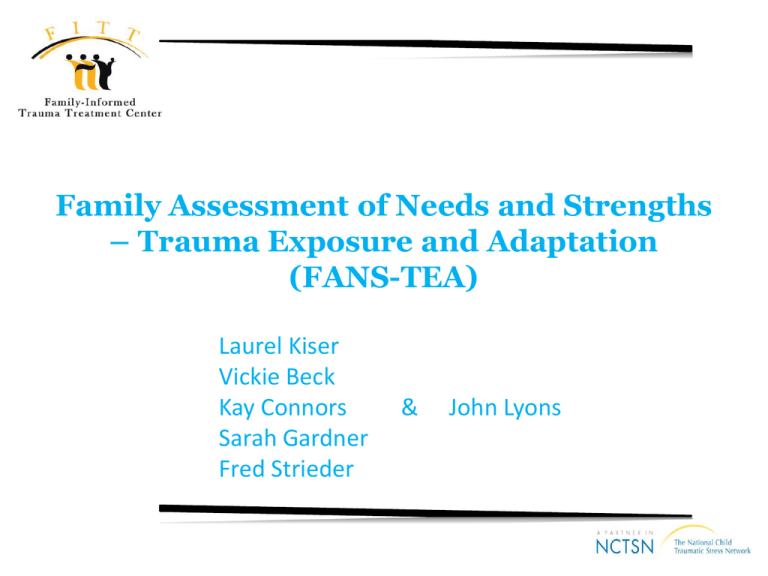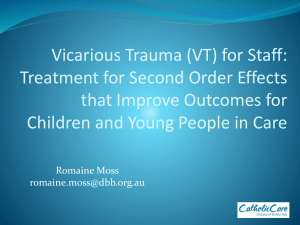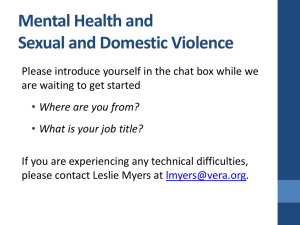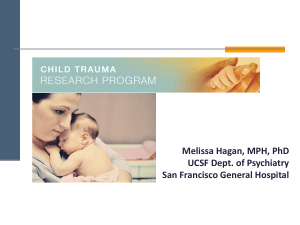Family Informed Trauma Treatment Center
advertisement

Family Assessment of Needs and Strengths – Trauma Exposure and Adaptation (FANS-TEA) Laurel Kiser Vickie Beck Kay Connors Sarah Gardner Fred Strieder & John Lyons Acknowledgements •Substance Abuse and Mental Health Services Administration (NCTSI Category II) •In developing the FANS-TEA, we build off of several existing versions of the CANS: –the CANS-TEA (Kisiel, Lyons, Saxe, Blaustein & Ellis, 2002) –Several of the trauma items were developed or adapted based collaborations with Cassandra Kisiel, Ph.D., Glenn Saxe, M.D., Margaret Blaustein, Ph.D., and Heidi Ellis, Ph.D., with the SAMHSA-funded National Child Traumatic Stress Network. –the Family Advocacy and Support Tool (FAST) –Additionally, we want to acknowledge the work of all those individuals who made contributions to development of the CANS family of instruments. Families with Complex Adaptations to Trauma • Too many families are exposed to accumulated traumatic circumstances. • Complex adaptations to trauma in families are defined by the intensity, duration, chronicity, or “toxicity” of the accumulated trauma, and by the nature of the family’s response. • Those families whose strengths have been overwhelmed by their accumulated traumatic stressors exhibit distress and disrupted family functioning. Families with Complex Adaptations to Trauma • Exposure to multiple traumas within a traumatic context • Systemic response – – – – – Multiple family members experiencing trauma-related distress Multiple family subsystems negatively impacted Family resources are insufficient to support needs Family unit trauma-related distress Family maladaptation with risk of becoming a trauma-organized system Child Response Sibling Relations Traumatic Context Family Unit Parent-Child Relations Adult/ Parental Response Intergenerational Response Time Individual and Family Outcomes Parenting Practices & Quality Adult Intimate Relations Acute and longer-term effects Individual development Family life cycle Adapted from Kiser & Black, 2005 Purposes 1) To document the range of strengths and needs exhibited by families affected by trauma, 2) To describe the contextual factors and systems that can support a family’s adaptation to trauma, and 3) To assist in the management and planning of services for families with exposure and adaptation to traumatic experiences. Administration • Completed by a trained clinician • Information is typically gathered during 1-3 sessions with the family. • Clinician may use the Family Trauma Treatment Interview (FTTI) for structuring the conversation with the family. • Clinician completes the FANS-TEA using the information collected. I. THE FAMILY TRAUMATIC CONTEXT In this section, we would like you to think about the experiences that your family has had regarding trauma and stressors. These traumas and stressors could have occurred to any member of the family or to the whole family together. For Family Traumatic Context, use the following categories/action levels: 0 indicates a dimension where there is no evidence of any trauma/stress of this type. 1 indicates a dimension where a single incident of trauma occurred or suspicion exists of trauma experiences; or mild stressor 2 indicates a dimension on which the family has experienced multiple traumas or a moderate degree of trauma/stressor. 3 indicates a dimension which describes repeated and severe incidents of trauma with medical and physical consequences; or major stressors. I. THE FAMILY TRAUMATIC CONTEXT • Items 1-10 cover different trauma types. sexual abuse physical abuse emotional abuse neglect medical trauma family violence community violence natural/manmade disaster political violence cultural violence I. THE FAMILY TRAUMATIC CONTEXT 11. IMMEDIATE RISK - This item refers to the family’s current risk of exposure to any of the previously rated traumas. 0 Family has no current risk of exposure as could be reasonably expected. 1 Family has some limited risk of exposure to trauma(s) but no current, on-going exposures. 2 Family is at high risk of experiencing trauma(s). 3 Family is experiencing on-going trauma(s). Family at risk of exposure to: (circle all that apply): sexual abuse, physical abuse, emotional abuse, neglect, medical trauma, family violence, community violence, natural or manmade disaster, political violence List family members at immediate risk: I. THE FAMILY TRAUMATIC CONTEXT • Items 12-17 cover potential contextual stressors/strengths: family life cycle stressors neighborhood safety community resources financial resources residential stability military transitions Assessing Family Needs & Strengths Section II 14 items assess the Family as a Whole III 11 items assess Adult family members IV 11 items assess Child family members V 3 items assess Intergenerational family matters VI 4 items assess Adult Intimate Partnerships VII 9 items assess Caregiving VIII 2 items assess Caregiver-Child Relations IX 3 items assess Sibling dynamics FANS-TEA Scoring Needs Strengths • '0' indicates no need for action • '1' indicates a need for watchful waiting • '2' indicates a need for action/moderate degree • '3' indicates the need for either immediate or intensive action • '0' indicates centerpiece strength • '1' indicates a strength that you can use in planning • '2' indicates an identified strength that must be built • '3' indicates the no strength identified II. THE FAMILY as a Whole 22. EFFICACY- This rating should be based on the family’s belief that it is effective in achieving its goals and able to successfully manage daily family life and handle stressors. 0 Family believes in itself and has confidence in its ability to successfully deal with family life. The family takes on problems and stressors with the attitude that they will be able to handle whatever happens. 1 Family members believe that they are able to handle most situations although they can be tentative about their ability to manage stressors at times. 2 Family has limited expectations about its ability to handle situations successfully. Family members are often surprised when they are successful at dealing with problems. 3 Family feels that it fails/is unable to handle most situations. Family members act based on the premise that “we are not able to cope with the things that happen to us”. VI. Adult Intimate Partners 61. PARTNERSHIP AFFECT MANAGEMENT - This item refers to the extent to which adult partners modulate or express emotions and manage their reactions in the context of their relationship. 0 This rating is given to adult partners with no difficulties co-regulating emotional responses; adult partners manage strong emotions in a healthy, adaptive way. They recognize and respond appropriately to the affect expressed... 1 This rating is given to adult partners with some minor difficulties with affect regulation. They generally recognize and respond appropriately to the affect expressed, but there are some miscues and miscommunications… 2 This rating is given to adult partners with moderate problems with affect regulation. They may exhibit marked shifts in emotional responses… 3 This rating is given to adult partners with highly dysregulated affect… I. Caregiving 65. SATISFACTION/MEANING OF CAREGIVING- This item refers to the importance placed on the role of caregiving and to the sense of accomplishment or pride that the caregiver feels related to carrying out her/his caregiving role and responsibilities. 0 Caregiver gives high priority to her/his caregiving role and responsibilities and gains significant satisfaction from carrying them out. 1 Caregiver places some importance on her/his caregiving role and responsibilities and gains some satisfaction from carrying them out. 2 Caregiver feels that her/his caregiving responsibilities must get done but only occasionally feels a sense of pride in accomplishing them. 3 Caregiver does not value her/his caregiving role and feels little or no sense of satisfaction for accomplishing any of her/his caregiving responsibilities. Caregiving is seen as a burden. FANS-TEA Triggers and Links • Triggers - indicate actions that should be considered based on the section or item rating: • Additional assessments recommended • Plans to be developed/implemented • Reports that need to be made • Referrals that need to be facilitated • Links - indicate additional materials or resources that may be valuable in assisting the clinician in treatment planning or service delivery. FANS-TEA Triggers and Links Links for items 8 & 9 - Disaster/Political Violence •Psychological First Aid was developed by the NCTSN and National Center for PTSD. •It is an evidence-informed approach for assisting children, adolescents, adults, and families in the aftermath of disaster and terrorism: www.nctsnet.org/nccts/nav.do?pid=typ_terr_ resources_pfa FANS-TEA Triggers and Links Section VII: CAREGIVING Needs [items = 5; range = 0-15]; Strengths [items = 4; range = 0-12] High Needs & Low Strengths Triggers - The following table identifies programs that effectively impact on parenting: Program Developer Parent Child Eyberg Interaction (2003) Therapy (PCIT) STAR (Stop, Think, Ask, Respond) Parenting Program Nicholson, Anderson, Fox & Brenner (2002) Essential Elements Evidence/ Outcomes Therapists coach parents on two major components: relationship enhancement and strategies for compliance. Utilizes cognitive behavioral & anger management techniques to help parents develop a “thoughtful” parenting style. Shown to be effective in reducing maternal stress and increasing the number of positive parentchild interactions. Research indicates decreased levels of verbal and corporal punishment, anger, stress, and child behavior problems following this intervention. Looking forward to your input: For more information on the FANS TEA or to review it, provide feedback, participate in beta testing e-mail Dr. Kiser at lkiser@psych.umaryland.edu Please visit the FITT Website to learn more about the FITT Center and FITT Model http://fittcenter.umaryland.edu








